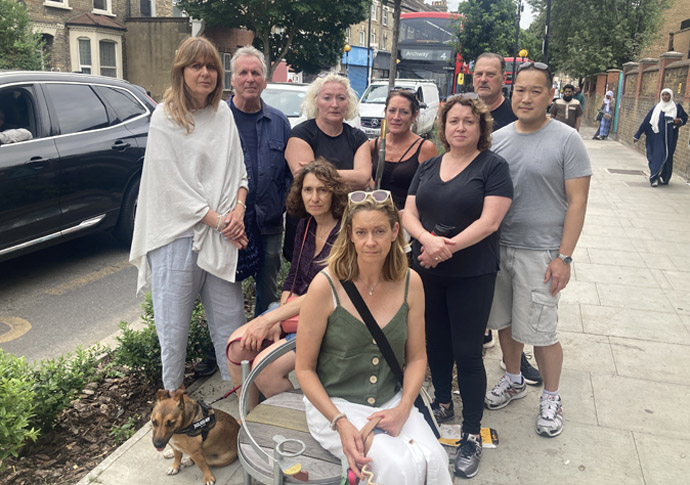Fresh calls to put the brakes on LTNs
Concern traffic queues on boundary roads may be leading to higher emissions from vehicles
Friday, 7th July 2023 — By Charlotte Chambers

Campaigners who are opposed to low traffic neighbourhoods, with vehicles backed up behind them in Blackstock Road
THE Town Hall is facing new calls to rethink its traffic polices amid claims queues of cars are building up on Blackstock Road and adding to emissions.
Council chiefs were told this week that the problem was worsening on some boundary roads where traffic was increasing as drivers avoided road closures mapped out in Islington’s collection of “Low Traffic Neighbourhoods”. These are becoming the only corridors open for those avoiding restricted areas that fall under the LTNs.
According to Islington’s own numbers, vehicles on Blackstock Road in Finsbury Park have increased from around 12,000 a day to more than 19,000 since the Highbury LTN was introduced in January 2021 – a new road layout which led to divided opinions.
Meanwhile, St Paul’s Road West also saw an increase in traffic of around 3,000 vehicles a day. When asked by the Tribune this week, the council said it last published figures from a pollution monitor outside Ambler Primary School in Blackstock Road in 2021. Updated sets of figures will be published later this year, a spokesman said.
Overall, Islington wants to cover 70 per cent of the borough in LTNs, with supporters of the measures suggesting patience will pay off in the long-term as people learn to leave their cars at home. The council’s belief is that this will reduce toxic emissions as people choose greener travel alternatives.
But Jo Sergeant, of the Keep Highbury Moving group, said the scheme had not been thought through.
“The town planning has completely failed,” she said. “When they actually planned these LTNs they didn’t do any joined-up thinking. Somebody somewhere said, ‘It’s a great idea to not allow traffic to cross from east or west to Highbury. So what we’ll do is we’ll stop that happening and we’ll push all the traffic through Blackstock Road.’ But the infrastructure of Blackstock Road is not ready for that. There aren’t any bus lanes, there’s no cycle lanes.”
Councillor Fin Craig, Islington’s Young People’s Champion and a paediatrician, said this week that LTNs were not the only answer, citing the traffic on boundary roads as a problem. She warned that if nothing was done children would continue to suffer from life-long health issues due to pollution.
But she added: “I am not opposed to LTNs but see LTNs as only one step in tackling this massive health crisis. I hope they will be part of the answer and that we can do more to reduce emissions, particularly on the boundary roads. As the adults in this community, we need to take responsible action to protect the current and future health of children, even where this is less convenient and not easy or popular.”
Lucy Facer lives on Liverpool Road in Highbury, which now sees 1,000 more vehicles a day more than its A-road neighbour Upper Street, in part due to changes at Highbury Corner.
She is calling for all roads in the upcoming Barnsbury and Laycock LTN to be closed to though traffic, leaving just Upper Street, Holloway, Caledonian and Pentonville roads to take vehicles.
She said: “We’ve got to reduce traffic and LTNs are the most effective way of changing people’s behaviour to choosing alternatives to driving short journeys.”
Labour’s Rowena Champion, Islington’s environment lead councillor, defended the seven LTNs already in place, saying “overall” traffic has not increased on boundary roads.
But she added: “We’re working closely with Hackney Council to see how we can improve Blackstock Road for everyone. We know that there’s more to do on Blackstock Road to reduce traffic and create a better atmosphere for all, and we look forward to working with the local community to reduce the volume and negative impact of traffic.”